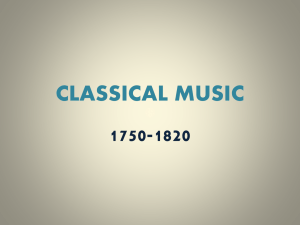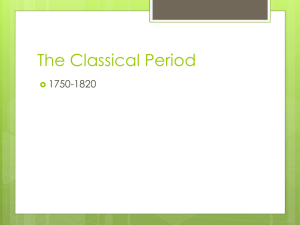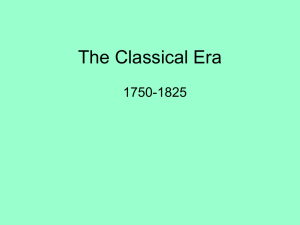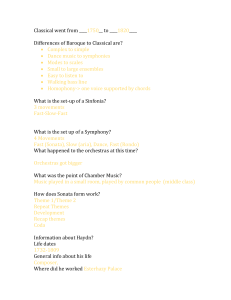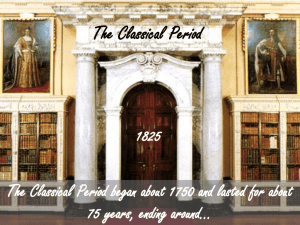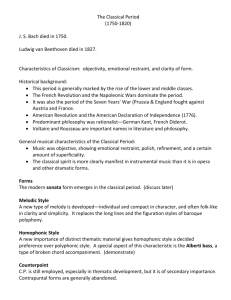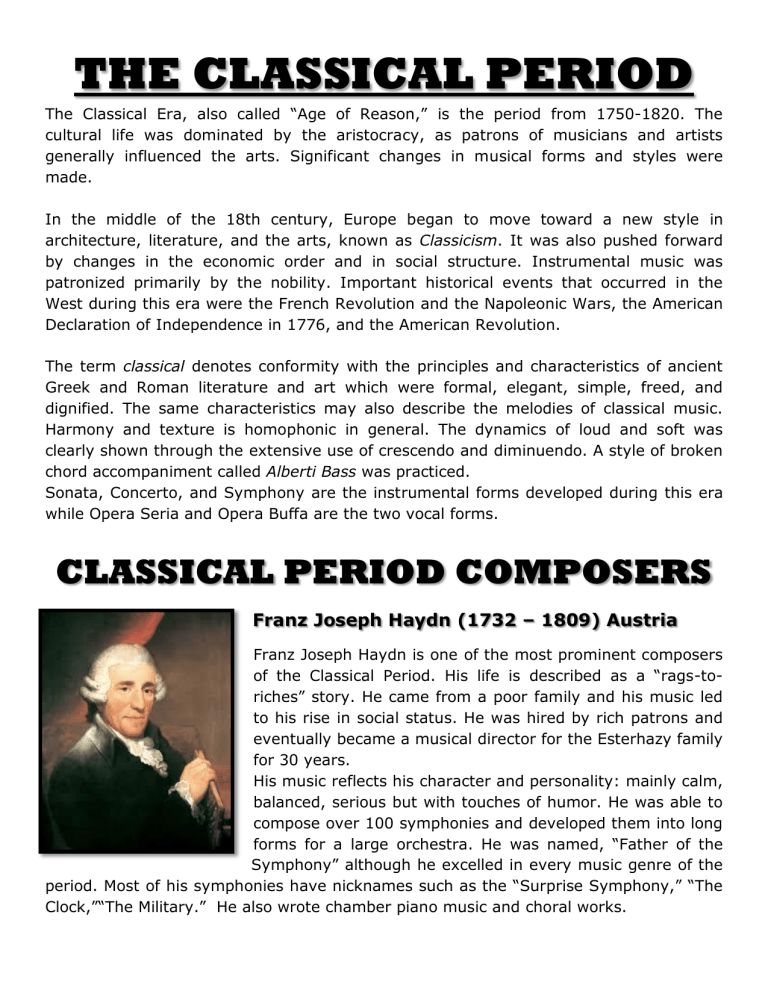
THE CLASSICAL PERIOD The Classical Era, also called “Age of Reason,” is the period from 1750-1820. The cultural life was dominated by the aristocracy, as patrons of musicians and artists generally influenced the arts. Significant changes in musical forms and styles were made. In the middle of the 18th century, Europe began to move toward a new style in architecture, literature, and the arts, known as Classicism. It was also pushed forward by changes in the economic order and in social structure. Instrumental music was patronized primarily by the nobility. Important historical events that occurred in the West during this era were the French Revolution and the Napoleonic Wars, the American Declaration of Independence in 1776, and the American Revolution. The term classical denotes conformity with the principles and characteristics of ancient Greek and Roman literature and art which were formal, elegant, simple, freed, and dignified. The same characteristics may also describe the melodies of classical music. Harmony and texture is homophonic in general. The dynamics of loud and soft was clearly shown through the extensive use of crescendo and diminuendo. A style of broken chord accompaniment called Alberti Bass was practiced. Sonata, Concerto, and Symphony are the instrumental forms developed during this era while Opera Seria and Opera Buffa are the two vocal forms. CLASSICAL PERIOD COMPOSERS Franz Joseph Haydn (1732 – 1809) Austria Franz Joseph Haydn is one of the most prominent composers of the Classical Period. His life is described as a “rags-toriches” story. He came from a poor family and his music led to his rise in social status. He was hired by rich patrons and eventually became a musical director for the Esterhazy family for 30 years. His music reflects his character and personality: mainly calm, balanced, serious but with touches of humor. He was able to compose over 100 symphonies and developed them into long forms for a large orchestra. He was named, “Father of the Symphony” although he excelled in every music genre of the period. Most of his symphonies have nicknames such as the “Surprise Symphony,” “The Clock,”“The Military.” He also wrote chamber piano music and choral works. Wolfgang Amadeus Mozart (1756 – 1791) Austria Wolfgang Amadeus Mozart is a child prodigy and the most amazing genius in musical history. At age five, he was already playing the violin and the harpsichord; at six, he was recognized as an exceptional pianist, and at seven, he was already composing excellent music. At age thirteen, he had written sonatas, concertos, symphonies, religious works, and operas and operettas. He experimented in all kinds of music and composed over 700 works. Unfortunately, due to mismanaged finances he lived his life in poverty, died young, and was buried in an unknown grave. He composed wonderful concertos, symphonies, and operas such as “The Marriage of Figaro” (1786), “Don Giovanni" (1789), and “The Magic Flute” which became popular. Other known works: "Eine Kleine Nachtmusik," "Symphony no. 40 in G Major," and "Sonata no. 11 in A Major K311." Ludwig Van Beethoven (1770 – 1827) Germany Ludwig Van Beethoven was born in Bonn, Germany to a family of musicians and studied music at an early age. He was the composer who bridged the late Classical era and the early Romantic era. He was a talented pianist and composer. His famous compositions include 32 piano sonatas, 21 set of variations, 9 symphonies, 5 concertos for piano, 16 string quartets, and choral music. His works include the “Missa Solemnis” (1818-1823) and opera “Fidelio” (1805). His known symphonies are: Symphony no. 3 ("Eroica"), no. 5, no. 6 ("Pastoral"), and no. 9 ("Choral"), which adds voices to the orchestra. He began to go deaf in 1796 but this did not become a hindrance. He continued composing through the help of an assistant and hearing gadget. Some of his famous compositions were made when he was deaf. Characteristics of Beethoven’s works: – His music veered toward larger orchestras. – Sound was centered on the violas and lower registers of the violins and cellos to give his music a darker mood. – All themes in a piece are tied together by one motif. – He developed musical themes and motifs extensively by means of modulation. – He used more brass instruments and dynamics. INSTRUMENTAL FORMS SONATA A multi-movement work for solo instrument, Sonata came from the word “Sonare” which means “to make a sound.” This term is applied to a variety of works for a solo instrument such as keyboard or violin. SONATA – ALLEGRO FORM The most important form that developed during the classical era consists of 3 distinct sections: Exposition, Development, and Recapitulation. – Exposition - the first part of a composition in sonata form that introduces the theme – Development is the middle part of the sonata-allegro form wherein themes are being developed – Recapitulation - repeats the theme as they first emerge in the opening exposition CONCERTO Concerto is a multi-movement work designed for an instrumental soloist and orchestra. It is a classical form of music intended primarily to emphasize the individuality of the solo instrument and to exhibit the virtuosity and interpretative abilities of the performer. The solo instruments in classical concertos include violin, cello, clarinet, bassoon, trumpet, horn, and piano. A concerto has three movements: fast, slow, and fast. - 1st Movement: Fast: Sonata-allegro form with expositions of the orchestra and then by the soloist 2nd Movement: Slow: Has more ornamentation than the First movement 3rd Movement: Fast: Finale: Usually in a form of rondo, resembling the last movement of the symphony and usually a short cadenza is used SYMPHONY – (SINFONIA) A multi-movement work for orchestra, the symphony is derived from the word sinfonia which literally means “a harmonious sounding together.” It is a classical music for the whole orchestra, generally in four movements. - 1st Movement: Fast: Sonata-allegro form - 2nd Movement: Slow: Gentle, lyrical – typical ABA form or theme and variation - 3rd Movement: Medium/Fast: Uses a dance form (Minuet or scherzo) - 4th Movement: Fast: Typically Rondo or Sonata form VOCAL FORMS (Classical Opera) OPERA is a drama set to music where singers and musicians perform in a theatrical setting. The two distinct styles of opera, Opera Seria and Opera Buffa, were developed during the Classical Period. – The Opera Seria (serious opera) usually implies heroic or tragic drama that employs mythological characters, which was inherited from the Baroque period. “Idomeneo” by Mozart is an example of Opera Seria. – The Opera Buffa (comic opera) from Italy made use of everyday characters and situations, and typically employed spoken dialogues, lengthy arias and was spiced with sight gags, naughty humor and social satire. “The Marriage of Figaro,” “Don Giovanni,” and “The Magic Flute” are examples of popular Opera Buffa by Mozart.
